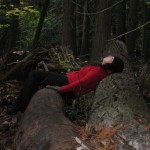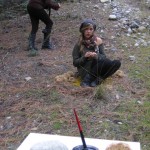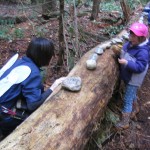CLICK HERE TO VIEW excerpt of “Woodhaven” VIDEO
(From Documentary by Loir Mairs and Nancy Holmes)
This class project received a Campus as Living Laboratory: Learning and Practicing Sustainability Grant. The purpose of The Living Laboratory Performance Project was to engage interdisciplinary performance students in site-specific theatre and guerrilla theatre, styles of performance that are inspired by local and global concerns and are designed and executed to promote a sense of belonging, community awareness and action. The goal for Theatre 201 was to develop perception and to research and explore diverse sources in the creation of new performance work. The work was based on the understanding that every aspect of our physical and emotional world can be represented in the human body. Students employed a creative process of research, exploration, translation, and communication. Course content evolved according to collectively determined interests and research.
Students in THTR 201 used a variety of sources to research issues of sustainability and then translated their findings into performance events. These performance events were created for two specific locations: the UBC O campus and the Woodhaven Nature Conservancy as part of the Woodhaven Nature Conservancy Eco Art Project.
Click on link below to view newspaper article:
Purpose/Aim of the project
Theatre is, by its very nature, inextricably linked to the community within which it is created. The vehicle for live performance is flesh and blood. It involves a symbiotic relationship between performer and audience in real space and real time. As performers, we try to “be present” or “body-mindful” in order to have an authentic experience and to share this with an audience. By asking a performer and an audience to simply be present and partake in a symbolic activity of the “here and now”, live performance provides a deeply significant and deeply needed experience of belonging. For how do we participate meaningfully and sustainably in the natural world if we experience ourselves as separate from its rhythms and its interdependency?
Relevance to learning objectives
The Living Laboratory Performance Project offered an opportunity for students to develop these skills while building a relationship both theoretically and practically between art and the community. The students’ work must culminate in meaningful communication with a targeted community in order for it to be successful. The Living Laboratory Performance Project emphasized this connection. It offered the opportunity to creatively communicate ideas and to model politically and ethically engaged forms of public life. Course content evolved according to collectively determined interests, research, and the resulting project proposals.
Methods/proposed activities
The performances themselves took many forms. They included site-specific performances at UBC O and at the Woodhaven Conservancy, installation work, flash mobs, guerilla theatre tactics, and conventional performance presentations in non-traditional settings. The form was dictated by content and content was determined by student research. Research sources included:
Woodhaven
- Topography of Woodhaven park (interpretation of space/physical place)
- Woodhaven poem, Nancy Holmes (interpretation of poetry for performance)
- Regional District Woodhaven Archives (use of found text in performance)
UBC Okanagan
- Topography surrounding UBC Okanagan campus (interpretation of space/physical place)
- Sustainability policies at UBC Okanagan (the use of found text in performance)
- UBC Okanagan student interviews regarding sustainability issues (verbatim theatre and its applications to performance)
Students were evaluated according to their independent research, their in-studio exploration and translation work, their final presentations (communication) and a peer evaluation.
Woodhaven
The Woodhaven Nature Conservancy contains three bioclimatic zones and their plants and animals, including some endangered species such as the Western Screen Owl which is on British Columbia’s Red List. Students researched and created four works in response to this environment: Tongue to Task, Whispers of Woodhaven, Guardian of the Woodlands, and All Secret Nest Holes. On October 24th, they performed their work for approximately 120 visitors. Excerpts from the program for this event are as follows:
Whispers of Woodhaven
Using objects, movement and text, performers tell the story of the life cycle of the cottonwoods of Woodhaven through the re-working and re-interpretation of Nancy Holmes poem “Fallen Trees.”
Tongue to Task
Through movement and striking imagery, performers experiment with ideas of consumption and how it directly affects natural areas such as Woodhaven. The title comes from a line of poetry “Take my tongue to task” in Nancy Holmes’ Woodhaven poems.
Nymphs, or Guardian of the Woodlands: The Changing of a Season
The “worker” nymphs keep the woodland and control the seasons. They are natural phenomena that occur in natural environments. At the urge of autumn, they have a lot of work to do.
All Secret Nest Holes
Park visitors are offered nests containing poems and secrets written about the “bird people’s” observations of the visitors themselves.



